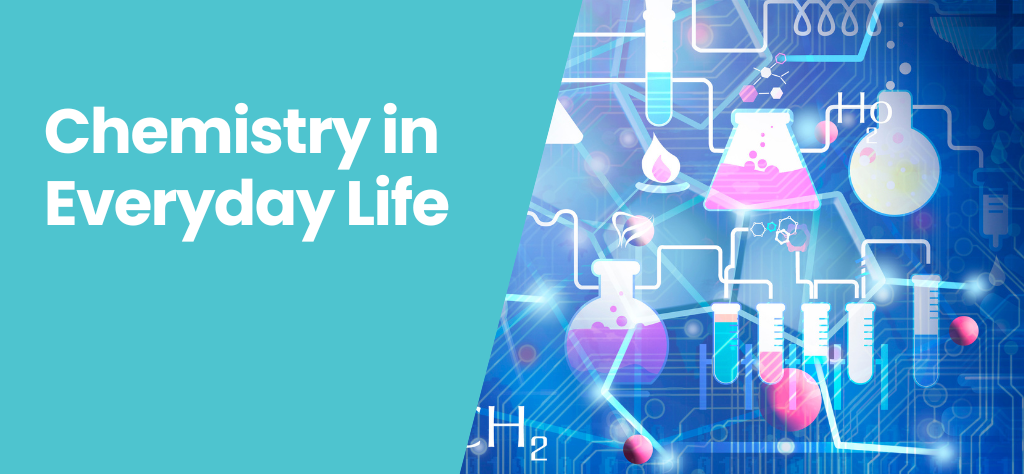If you are studying chemistry, then you must have wondered about the importance of chemistry in everyday life. Chemistry is the branch of science which deals with the investigation of the properties and changes of matter.
Synthetic Materials
The materials created by man using the natural materials, are known as synthetic materials.
Cement
- It was discovered by an English Mason, Joseph Aspdin in 1824. He called it Portland cement because he thought that it resembled the limestone found in Portland.
Approximate Composition of Portland cement
Calcium oxide(CaO) 60-70%
- Silica (Si𝑂2) 20-25%Alumina (𝐴𝐼2𝑂3) 5-10%Ferric oxide (𝐹𝑒2𝑂3):2-3%Raw materials are limestone (provides lim(e), clay (provides alumina and silic(a), gypsum (reduces the setting time of cement).When water is mixed with cement and left as such for sometime, it becomes a hard mass. This is known as setting of cement. It is an exothermic process, therefore cement structures have to be cooled upto 7 days by sprinkling water.Mortar is a mixture of cement, sand and water. It is used for plastering walls and binding bricks and stones.Concrete is a mixtures of cement, sand, gravel or small pieces of stone and water. It is used for the construction of floors.
- The structure having iron rods embedded in wet concrete, is known as reinforced concrete.
Glass (𝑵𝒂𝟐𝑶.𝑪𝒂𝑶.𝟔𝑺𝒊𝑶𝟐)
It is a super cooled liquid of silicates.
- Raw material used for the formation of glass are sodium carbonate, calcium carbonate and sand.
- Finely powdered mixture known as batch, is mixed with cullet (broken glass pieces) and then fused in a tank furnace at 1673 K. After few hours, molten glass is obtained.
- Molten glass is cooled slowly and uniformly. The process of slow and uniform cooling is known as Annealing.
- Different addition may produce different coloured glasses.
| Substance used | Colour of glass |
| Cuprous oxide | Red |
| Cupric oxide | Peacock blue |
| Potassium dichromate | Green or Greenish yellow |
| Ferrous oxide | Green |
| Ferric oxide | Brown |
| Manganese dioxide | Light pink, in excess black |
| Cobalt oxide | Blue |
| Gold chloride | Ruby |
| Cadmium | Yellow |
| Carbon | Amber colour |
Variety of glass and Uses
- Soft glass – It is a mixture of sodium or calcium silicates. It is used in making window glass, mirrors and common glass wares etc.
- Hard glass – It is a mixture of potassium and calcium silicates. It is more resistant to the action of acids for making hard glass apparatus.
- Flint glass – It is mainly a mixture of sodium, potassium and lead silicates. It is used in making bulbs and optical instruments.
- Pyrex glass (Borosilicate glass) – It is used in making pharmaceutical containers, lab apparatus and over ware.
- Quartz glass (Silica glass) – It is used in the preparation of chemical apparatus and optical instrument.
- Crookes glass – It is used for making lenses for spectacles.
- Photochromatic glass – On exposure to bright light, photochromatic glass darkens temporarily. So, it is very useful as a Sun shield.
- Safety glass – The three layers are joined together by the action of heat and pressure. It does not break easily under impact and is used in auto vehicle wind shield.
- Optical glass – It is used for making lenses for microscope, telescope and spectacles.
- Glass fibres – used as insulating material in oven, refrigerator etc.
- Optical fibres – are extensively used in telecommunication surgical operations etc. Optical fibres can transmit images round corners.
- Lead crystal glass – Lead glass has a high refractive index. So, it is used for making expensive glass ware.
- Etching of glass – Glass is attacked by hydrofluoric acid (H(F), therefore it is used in the etching of glass.
Featured image courtesy: leverageedu
Some Common Elements and Compounds



